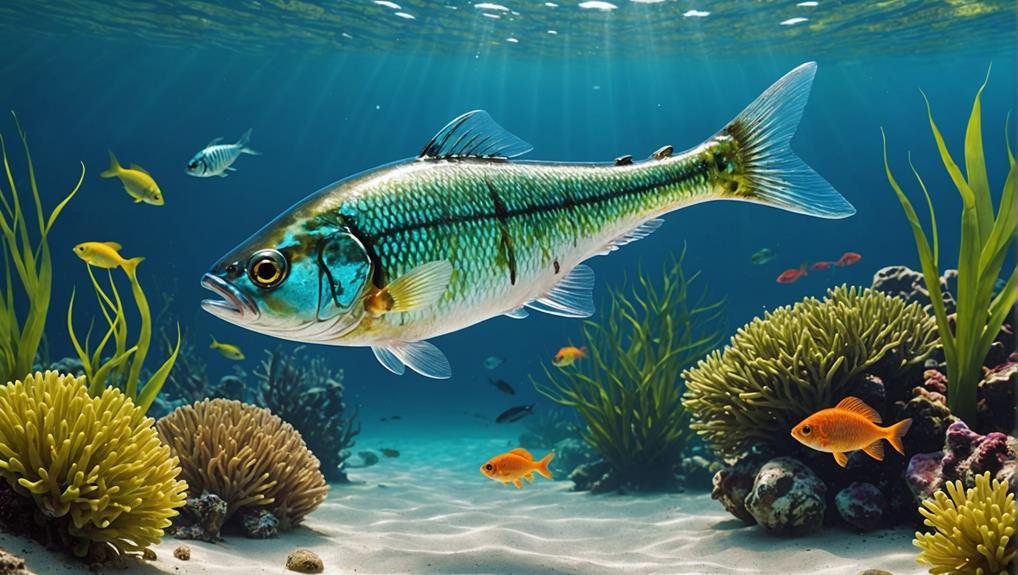Understanding their diverse range and specific applications becomes crucial when adding crankbaits to your fishing arsenal. These lures, crafted to imitate injured baitfish, come in different varieties, such as shallow, medium, and deep diving crankbaits, each tailored for various fishing conditions. But what truly distinguishes them? Is it the movement, the resonance, or the depth they achieve? By understanding the nuanced distinctions between billed and lipless crankbaits, you’ll be prepared to make knowledgeable choices on the water. Let’s look into how these selections can influence your fishing success.
Key Takeaways
- Crankbaits come in shallow, medium, and deep diving variations to target different water depths.
- Billed crankbaits offer precise depth targeting, while lipless crankbaits are versatile in various scenarios.
- Deep diving crankbaits like Berkley Flicker Shad can reach depths of 11-13 feet.
- Medium diving crankbaits, such as the Bandit 200 Series, target 6-12 feet depths.
- Varying retrieval techniques, including crank and pause, can effectively mimic distressed baitfish to trigger strikes.
Types of Crankbaits
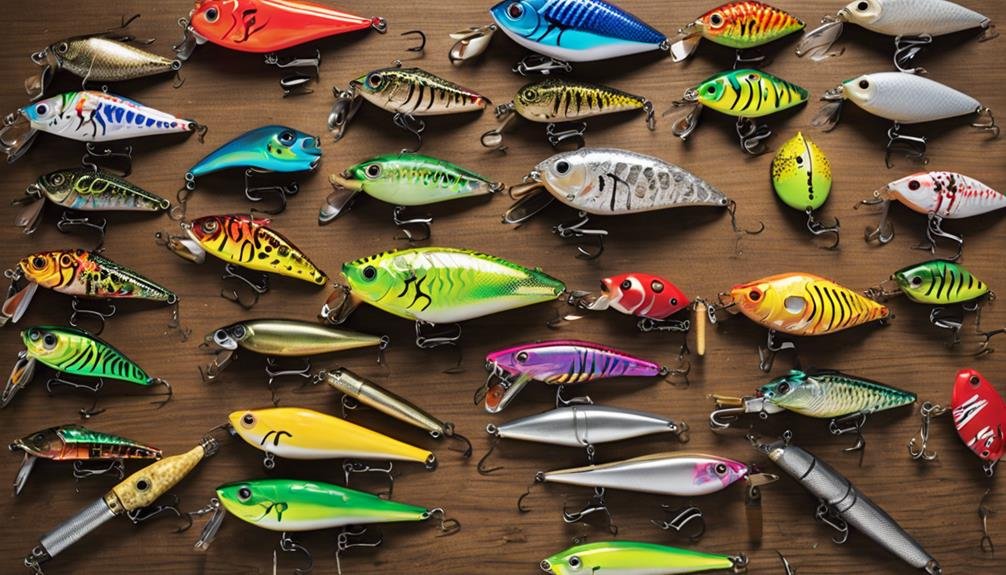
Understanding the different types of crankbaits is essential to fishing successfully with them. One vital type is the diving crankbait. These crankbaits are designed with a bill that allows them to dive to specific depths, making them incredibly versatile for different fishing conditions.
Diving crankbaits are categorized based on how deep they can dive: shallow, medium, and deep.
Shallow-diving crankbaits are perfect for fishing in water more than five feet deep. They also target fish hiding in vegetation or near the surface.
Medium diving crankbaits can reach depths of five to ten feet, making them ideal for fishing in mid-level waters where fish might be suspended.
Deep diving crankbaits go beyond ten feet, allowing you to target fish that dwell in deeper waters.
Understanding the diving depth of your crankbait is essential. You maximize your chances of catching more fish by matching the crankbait’s depth to the water depth you’re in. Whether in a shallow pond or a deep lake, choosing the right diving crankbait guarantees you are in the strike zone, where fish are most likely to bite.
Billed Vs. Lipless Crankbaits
Choosing between billed and lipless crankbaits can often be the key to a successful fishing trip. Billed crankbaits feature a diving bill that pushes them to specific depths, making them ideal for deep-water fishing. The bill not only controls the depth but also produces particular actions that can effectively attract fish.
On the other hand, lipless crankbaits vibrate without a bill, offering a unique action and versatility in various fishing scenarios.
Billed crankbaits are your go-to choice if you fish at certain depths. Different bill styles can create various actions, from wide wobbles to tight wiggles, enhancing their appeal.
However, when you need versatility, lipless crankbaits shine. Their lack of a bill allows them to sink at different rates and cover a range of water columns. They also produce a distinct vibration that can trigger strikes from various fish species.
Understanding these differences can greatly enhance your fishing success. Billed crankbaits are perfect for precision depth targeting, while lipless crankbaits offer unmatched versatility and a different vibration appeal, making them essential in your tackle box.
Diving Depth Variations
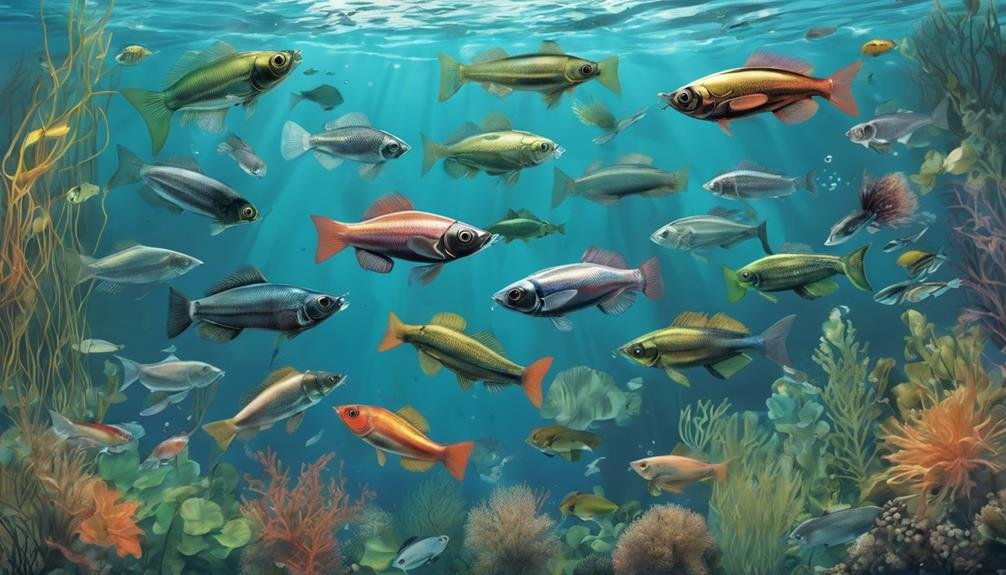
Understanding the diving depth variations of crankbaits can greatly enhance your fishing game. Crankbaits are designed to dive to specific depths, making it essential to know which type to use based on water conditions and your target species. Some crankbaits are built for shallow dives, while others reach depths of 10-20 feet or more, perfect for targeting fish in deep water.
Choosing the right diving depth crankbait can distinguish between a successful catch and a missed opportunity. For instance, if you’re a bass lurking in deep water, a deep diving crankbait that reaches 20 feet is your best bet. Conversely, a a shallow diving model is more appropriate for fish near the surface for fish near the surface.
Here is a reference table for different diving depth variations:
| Crankbait Type | Diving Depth |
|---|---|
| Shallow Diving | 0-5 feet |
| Medium Diving | 6-12 feet |
| Deep Diving | 13-20+ feet |
Fishing Gear Set-Up
A solid fishing gear set-up is vital for maximizing the effectiveness of your crankbait fishing. Start with a medium to heavy baitcasting rod, which gives you the backbone to handle the fishing lure’s resistance and the fish’s fight. Pair this with a high-speed baitcasting reel. A reel with a good drag system guarantees you can manage the tension when a fish bites.
Next, choose a sturdy line like fluorocarbon or braided. These lines offer better control and durability compared to monofilament. Fluorocarbon is nearly invisible underwater, enhancing your chances of a strike, while a braided line provides excellent strength and sensitivity.
Consider investing in a depth finder and trolling motor. A depth finder helps you identify the water depth and locate fish, making your crankbait more efficient.
The trolling motor allows precise maneuvering and positioning, which is essential in targeting specific areas.
Deep Diving Crankbaits
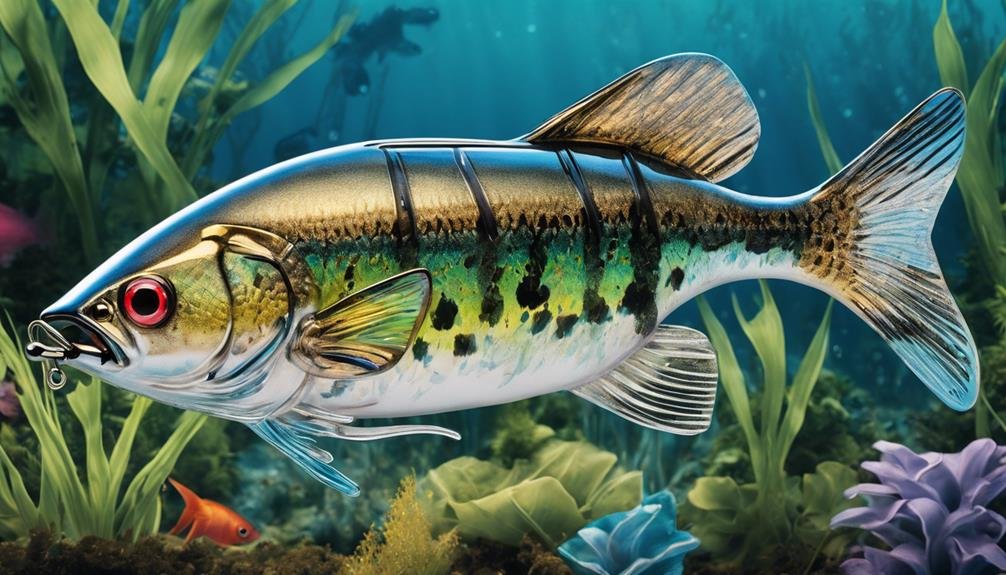
When you’re targeting fish in deeper waters, deep-diving crankbaits are essential. These specialized lures can reach depths that shallow-diving crankbaits simply cannot, making them vital for anglers aiming to catch fish below the surface.
One great option is the Berkley Flicker Shad crankbait, which can dive between 11 and 13 feet. It’s Ideal for getting down to where the fish are hiding.
Another effective choice is the Bandit 300 Series Deep Diving Crankbait. Measuring 2 inches and weighing 3/8 ounces, it is designed to reach deeper depths easily.
If you’re fishing for walleye, consider the Cotton Cordell Wally Diver Crankbait. Its slender profile and deep-diving capabilities make it an excellent lure for this species.
Here are three reasons to add deep diving crankbaits to your tackle box:
- Depth Reach: These lures can gereachepths, whereas shalloshallow-divingbaits can increase your chances of catching deeper-dwelling fish.
- Species-Specific: Some models are specially designed for certain species, like the Cotton Cordell Wally Diver for walleye.
- Versatility: They offer different actions and profiles to suit various fishing conditions and preferences.
Shallow Diving Crankbaits
Shallow-diving crankbaits are must-haves for anglers targeting fish near the water’s surface or around structures like rocks and vegetation. These lures mimic shallow-water prey, making them irresistible to various fish species. One standout option is the Lucky Craft LC 1.5, which imitates prey in shallow waters and dives to a specific maximum depth range, perfect for those tight spots where fish hide.
If you’re looking for something with some flair, the Berkley Flicker Shad Shallow Crankbait offers a real shad imitation with maximum rattle and roll action. This ‘baiting movement can draw fish out from the cover, making your fishing experience more successful.
Thanks to its unique flat-sided profile, the Berkley Frittside Shallow Diving Flat-Sided Crankbait is designed for shallow and medium depths, making it a versatile choice for various fishing conditions.
Shallow-diving crankbaits are particularly effective around cover like vegetation or rocks, where fish often seek refuge. They’re versatile and can attract various fish species, giving you a reliable option for different scenarios. Whether a novice or a seasoned angler, these crankbaits are essential in your tackle box.
Medium Diving Crankbaits
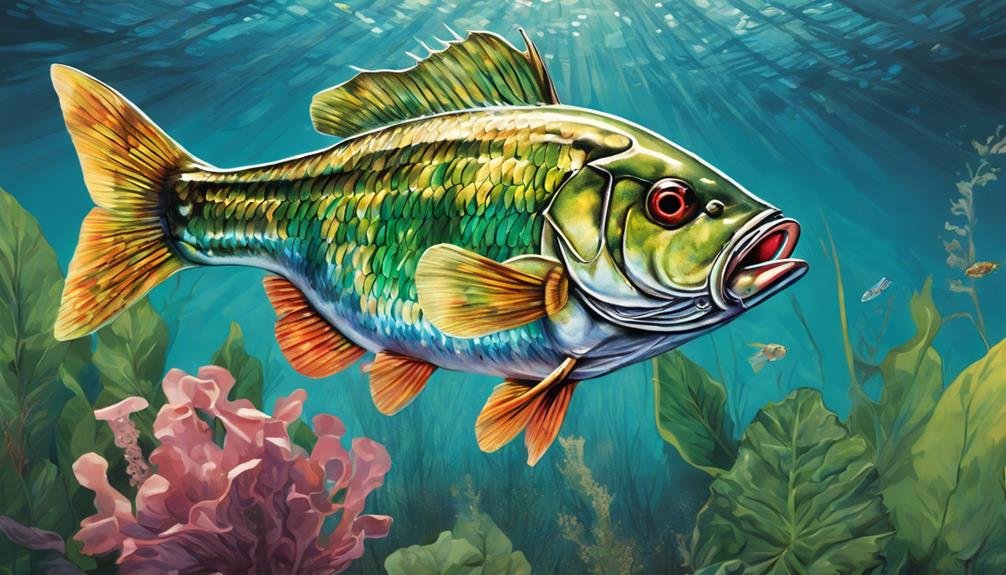
Medium-diving crankbaits are essential for anglers targeting fish at moderate depths, typically ranging from 6 to 12 feet. These lures are designed to dive to the perfect depth where many fish species are most active, making them versatile tools in your tackle box.
Here are three top-rated medium diving crankbaits you should consider:
- Bandit 200 Series Medium Diving Crankbait: Retailing at $7.99, this crankbait weighs 1/4 ounce and is 2 inches long. It’s It’sect for medium-depth fishing, offering reliable performance and consistent results.
- Strike King Mr. Crappie Slab Hammer SHCC3: At $5.94, this 3-inch crankbait is rated 5.0/5.0 for its effectiveness. It is versatile and a great choice for targeting various fish species at moderate depths.
- Rebel Big Craw: This two 1/2-inch crtwotwonkbait, also rated 5.0/5.0, excels at mimicking crawfish, a favorite prey for many fish species. It’s It’sst-have if you want to add realism to your fishing strategy.
Medium-diving crankbaits like these can significantly impact your fishing success. Selecting the right lure will increase your chances of landing that big catch at medium depths.
Specialized Crankbaits
Specialized crankbaits are indispensable tools in any angler’s arsenal. They are designed to target specific fish species precisely. With a wide range of colors, weights, and bill designs, you can tailor your approach to the exact fish you’re looking for.
Take the Berkley Flicker Shad Jointed Crankbait, for example. It’s an articulated bait that is ideal for trolling walleye. Its jointed body mimics the natural movement of prey, making it irresistible to your target fish.
On the other hand, the Strike King KVD Square Bill 1.5 Hard Knock Crankbait, with its two 3/4-inch length and 3/8-ounce weight, excels in shallow water. The hard knock feature adds a unique sound, drawing bass out from their hiding spots.
The Rapala Jointed Shad Rap 07 Deep Diving Crankbait stands out for deep waters. This rattling, suspending lure has a wide action that effectively attracts fish lurking in the depths. Its ability to dive deep while maintaining its enticing movement makes it a go-to for pike and large bass species.
High-End Crankbaits
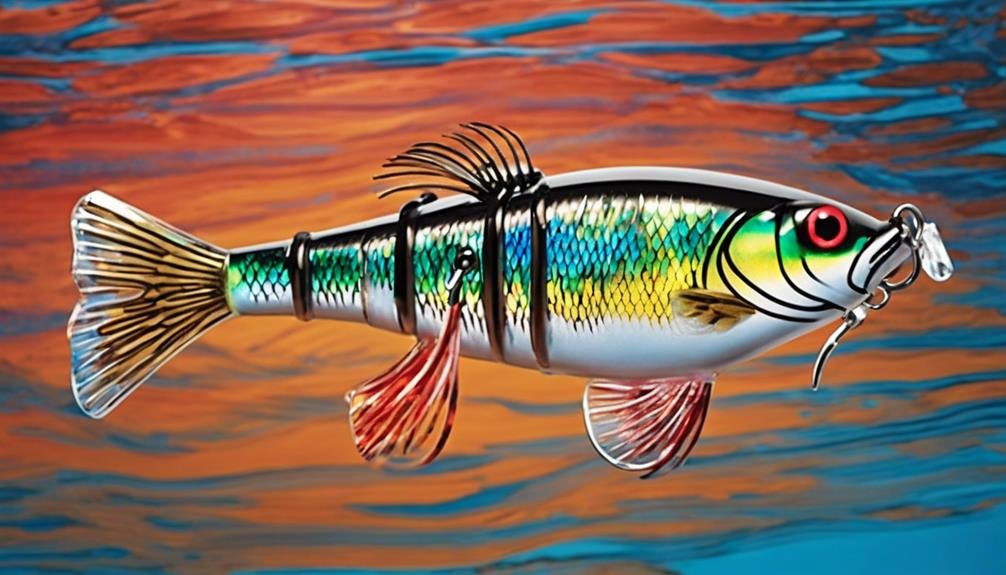
While specialized crankbaits offer targeted precision for specific fish species, top-tier crankbaits enhance your fishing game’s performance, and versatility options like the SPRO John Crews Little John Extreme 70 can make a noticeable difference. These crankbaits plunge to greater depths, perfect for reaching those elusive fish hiding in deeper waters.
Crafted by top professionals, high-end crankbaits provide superior performance and durability. For instance, the Strike King Gravel Dawg 10 crankbait is a 3.5-inch deep diver specifically engineered to meet the demands of experienced anglers. Its precision design ensures it can handle the challenges of serious fishing while delivering peak action to attract fish effectively.
Here’Here’syou should consider high-end crankbaits:
- Durability: Constructed to withstand the harshest conditions.
- Performance: Exceptional action and diving capabilities.
- Effectiveness: Boosts your chances of landing more and larger fish.
Another outstanding choice is the Rapala DT Series Crankbait DT10, crafted with metimeticulous craftsmanship. Incorporating-tier crankbaits into your maarsenal makeover for successful and enhanced enjoyabletrieves
When working crankbaits, vary your retrieve by bouncing off structures to trigger more strikes.
Experiment with a pause and crank technique, which often proves more effective than a straight retrieve.
Varying Retrieval Techniques
Experimenting with varying retrieval techniques is crucial to maximize your success with crankbaits. Different retrieval methods can trigger strikes from bass, especially when they’re finicky. Here are some effective tech methods to incorporate into your crankbait fishing strategy:
- Crank and Pause: This technique involves reeling in your crankbait and pausing momentarily. The erratic stop-and-go motion mimics a distressed baitfish, making it irresistible to bass. Pauses can vary in length, so try different durations to see what works best on a given day.
- Speed Variations: Altering the speed of your retrieve can also make a big difference. Sometimes a slow, steady retrieve will trigger strikes, while other times a fast, erratic retrieve works better. Mix it up and adapt based on the bass bass.
- Rod Manipulation: Instead of depending solely on your reel, manipulate your crankbait more with the rod. Subtle twitches, pulls, and jerks with the rod tip can enhance the lure, making it more natural and appealing to bass.
Optimizing Deflection Strategies
Building on the varied retrieval techniques, optimizing deflection strategies can greatly enhance your crankbait success. Crankbait fishing shines when your lure deflects off bass-holding structures like rocks, stumps, or submerged logs. This sudden change in direction often triggers reaction strikes from bass, making it an essential tactic to master.
To start, don’t do a single retrieve. Vary your crankbait retrieval patterns until you find what works best on a given day. Bass can be unpredictable, and what worked yesterday mightn’t work today. A mix of speeds and angles can significantly affect your success rate.
Experienced anglers recommend working the lure more with your rod than your reel. This gives you better control over the crankbait and allows for more precise deflections.
A quick rod movement can help you bounce the lure off a structure, creating an erratic action that bass find irresistible.
Just remember, crankbaits can be hazardous if not handled correctly. Always exercise caution, especially when removing hooks from a caught fish. With these strategies, you’re on your way to mastering crankbait fishing and upping your catch rate.
Pause and Crank
Often overlooked but remarkably effective, the”plus” and cran” re” sieve can greatly boost your crankbait fishing success. By pausing the crankbait intermittently during retrieval, you mimic a wounded or struggling baitfish, which triggers a predatory response from the bass. This technique often outfishes a straight, continuous retrieve, making it a valuable strategy in your angling arsenal.
To get the most out of the”plus” and cran” re” sieve, follow these tips:
- Vary Your Pauses: Experiment with different speeds and durations of pauses. Sometimes a rief stop is enough, while other times, a longer pause will do the trick.
- Use Your Rod: Don’t rely solely on the reel. Use your rod to impart action to the crankbait during the pauses. This added movement can make the bait seem even more erratic and enticing.
- Observe and Adapt: Pay attention to how bass responds to different retrieve patterns. Adjust your technique based on what works best in your specific fishing conditions.
Conclusion
Mastering crankbaits can greatly enhance your fishing success. You’ll have a strategic edge by understanding the differences between billed and lipless crankbaits and choosing the right diving depth for your target fish. Pair the correct fishing gear with specialized crankbaits, and use varied retrieval techniques to entice those predatory fish. You’ll find more bass, walleye, and pike with practice and experimentation than ever before.
FAQs
What is a crankbait, and how does it work?
A crankbait is a fishing lure designed to mimic abaitfish’ss or other movements in the water. It has a hard body, often made of plastic or wood, with a plastic lip or bill on the front that causes the lure to dive and wobble when retrieved. The thedesigncrankbait’ss design creates a swimming motion that attracts predatory fish like bass, pike, and walleye. The depth at which a crankbait dives and the speed at which it wobbles can be adjusted by varying the retrieve speed and the size of the bill.
Key Features:
- Mimics Baitfish: Imitates the movement of prey in the water.
- Diving Action: The plastic lip causes the lure to dive and wobble.
- Attracts Predators: Effective for catching species like bass, pike, and walleye.
What are the different types of crankbaits?
Crankbaits come in several types, each designed for specific fishing conditions and depths:
- Shallow-diving crankbaits: These have a small lip designed to dive to shallow depths (0-5 feet). They are ideal for fishing near the surface or over shallow structures.
- Medium Diving Crankbaits: With a medium-sized lip, these crankbaits can dive to depths of 5-10 feet, making them versatile for various water conditions.
- Deep-diving crankbaits: These crankbaits crankbaits have a large lip that allows them to dive to depths of 10 feet or more. They are perfect for targeting fish holding deep in the water column.
- Lipless Crankbaits: These crankbaits have no lip and are designed to sink to the desired depth. Adjusting the retrieval speed makes them excellent for covering a wide range of depths.
Types of Crankbaits:
- Shallow Diving: For surface and shallow water fishing.
- Medium Diving: Versatile, suitable for moderate depths.
- Deep Diving: Targets fish deep in the water column.
- Lipless: Adjustable depth, great for varied water conditions.
How do you fish with a crankbait effectively?
Fishing with a crankbait involves understanding how to retrieve the lure to mimic the natural movement of prey. Here are some tips for effective crankbait fishing:
- Vary Your Retrieve Speed: Experiment with different retrieval speeds to see what triggers bites. Faster retrieves create more erratic movements, while slower retrieves produce a more subtle action.
- Target Structures: Crankbaits are particularly effective when fished around structures like rocks, logs, and weed beds where predatory fish are likely to ambush prey.
- Bounce-Off the Bottom: Allow the crankbait or other underwater structures to bounce off the bottom. This action mimics a fleeing baitfish and can provoke aggressive strikes from nearby fish.
- Match the Hatch: Choose a crankbait that resembles the local baitfish’s size and color in the water you’re eating. This increases the likelihood of attracting fish.
Fishing Tips:
- Vary Retrieve Speed: Adjust to find what triggers fish.
- Target Structures: Fish around rocks, logs, and weeds.
- Bounce the Lure: Create erratic movements by hitting the bottom.
- Match the Hatch: Use colors and sizes that mimic local baitfish.
